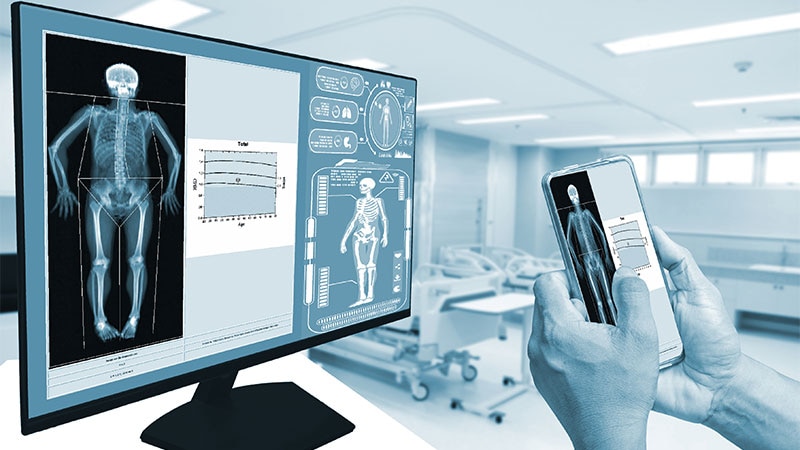Core Concepts
Detecting osteoporosis risk through a quick and inexpensive blood test.
Abstract
TOPLINE:
Researchers identified SNPs linked to osteoporosis risk from a drop of blood.
METHODOLOGY:
Blood samples were diluted and subjected to rapid thermolysis to extract DNA.
DNA was applied to an electrochemical device with gold electrodes for SNP detection.
Five SNPs associated with osteoporosis risk were detected and validated.
TAKEAWAY:
A portable device was developed to detect osteoporosis-associated SNPs from blood samples.
The entire assay was completed in 15 minutes at a low cost.
IN PRACTICE:
The platform has potential for automated SNP genotyping at the point of need.
SOURCE:
Study published in ACS Central Science by INTERFIBIO Research Group.
LIMITATIONS:
No study limitations reported.
DISCLOSURES:
Study received no commercial funding, and authors have no relevant financial relationships.
Quick, Inexpensive Test Detects Osteoporosis Risk From Blood
Stats
"The entire assay from the addition of the thermolyzed blood sample to the readout of the results was complete in just 15 minutes, with a cost per SNP, on a laboratory scale, including the cost of the electrode array and all reagents, of 0.3 euro (0.33 USD)."
Quotes
"The platform is completely generic and has immense potential for deployment at the point of need in an automated device for targeted SNP genotyping with the only required end-user intervention being sample addition." - Authors
Key Insights Distilled From
by Marlene Busk... at www.medscape.com 07-31-2023
https://www.medscape.com/viewarticle/994978
Deeper Inquiries
How can this innovative blood test impact the early detection and prevention of osteoporosis?
This innovative blood test has the potential to revolutionize the early detection and prevention of osteoporosis by providing a quick and inexpensive way to assess an individual's genetic predisposition to the condition. By detecting specific single nucleotide polymorphisms (SNPs) associated with osteoporosis risk from a simple blood sample, healthcare providers can identify individuals who may be at a higher risk of developing the disease. This early identification allows for targeted interventions such as lifestyle modifications, dietary changes, and early pharmacological interventions to prevent or slow down the progression of osteoporosis. Additionally, by enabling early detection, this test can help in implementing proactive measures to improve bone health and reduce the likelihood of fractures, ultimately leading to better outcomes for patients at risk of osteoporosis.
What potential challenges or ethical considerations might arise from widespread use of genetic testing for osteoporosis risk?
The widespread use of genetic testing for osteoporosis risk may present several challenges and ethical considerations. One major concern is the potential for genetic discrimination, where individuals who are identified as having a higher genetic risk of osteoporosis may face discrimination in areas such as employment, insurance coverage, or access to healthcare. There is also the risk of psychological distress for individuals who receive information about their genetic predisposition to osteoporosis, leading to anxiety, depression, or unnecessary worry. Additionally, there may be issues related to the accuracy and interpretation of genetic test results, as well as concerns about data privacy and the security of genetic information. Ensuring informed consent, genetic counseling, and strict adherence to ethical guidelines are essential to address these challenges and protect the rights and well-being of individuals undergoing genetic testing for osteoporosis risk.
How can the development of this device for SNP genotyping in various conditions benefit medical research and personalized treatment approaches?
The development of this device for SNP genotyping in various conditions holds significant promise for advancing medical research and personalized treatment approaches. By enabling rapid and cost-effective detection of specific genetic variations associated with different health conditions, this device can facilitate large-scale genetic studies to better understand the genetic basis of diseases such as osteoporosis, cardiovascular disorders, infectious diseases, and more. This, in turn, can lead to the identification of novel genetic markers, pathways, and therapeutic targets for these conditions. Furthermore, the ability to perform targeted SNP genotyping in a portable and user-friendly manner opens up opportunities for personalized medicine, where treatment decisions can be tailored based on an individual's genetic profile. This device can help healthcare providers deliver more precise and effective treatments, optimize drug selection and dosing, and improve patient outcomes by taking into account each patient's unique genetic makeup. Overall, the development of this device has the potential to revolutionize medical research and clinical practice by integrating genetic information into personalized treatment strategies.
0
More on Healthcare
